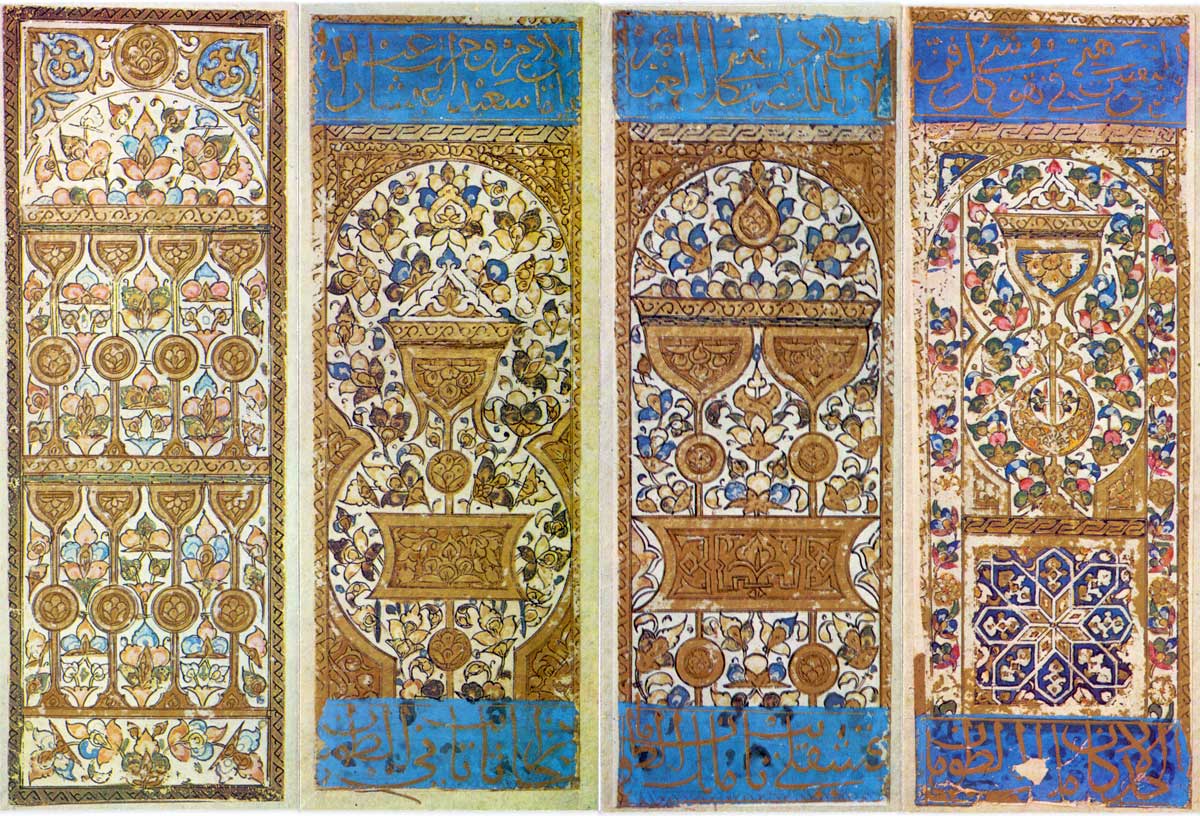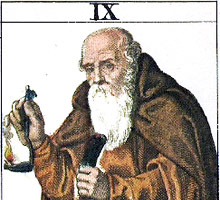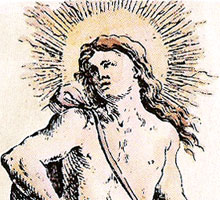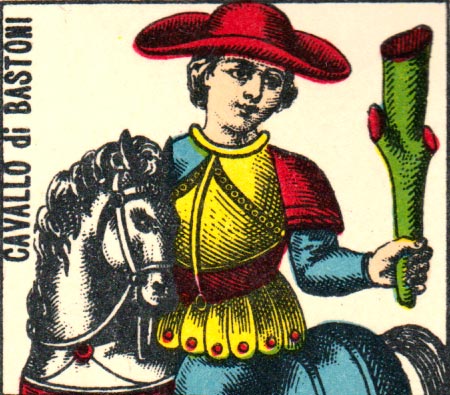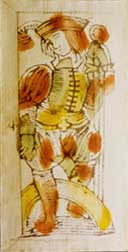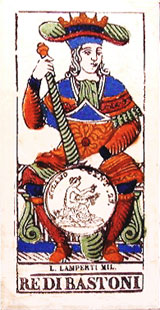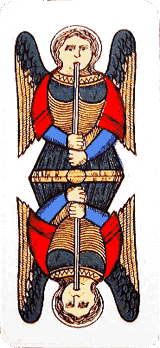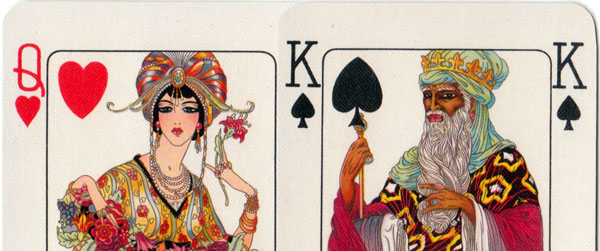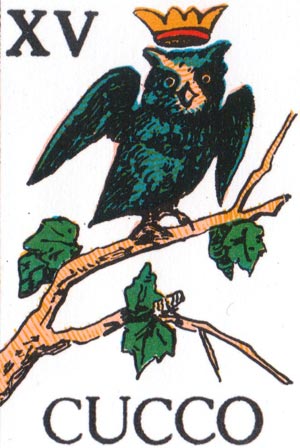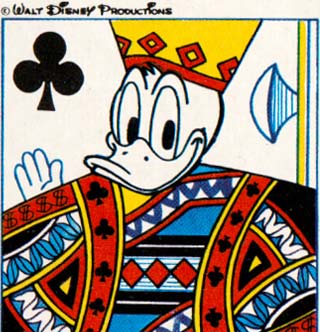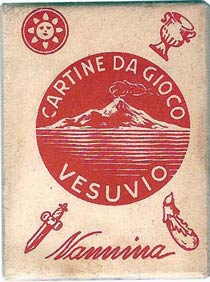Italian Playing Cards
The first reliable evidence that playing cards were being used in Italy is from 1376, when a game called 'naibbe' is forbidden in a decree, with the implication that the game had only recently been introduced there.
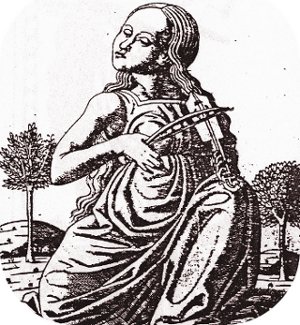
Above: Tarocchi di Mantegna, c.1465.
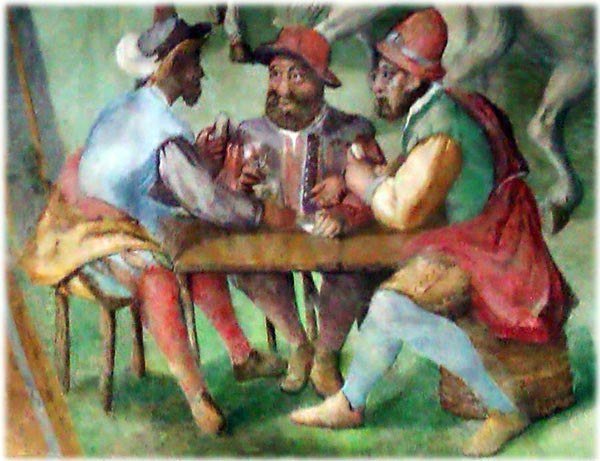
Above: detail from “La Sala de Las Batallas” mural painting in El Escorial palace (Madrid) produced by a team of Italian artists overseen by Orazio Cambiasso, late 16th century.
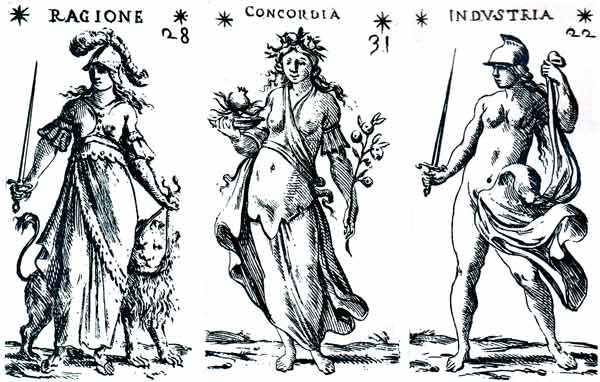
Above: Mitelli’s ‘Gioco di Passatempo’, 1690.
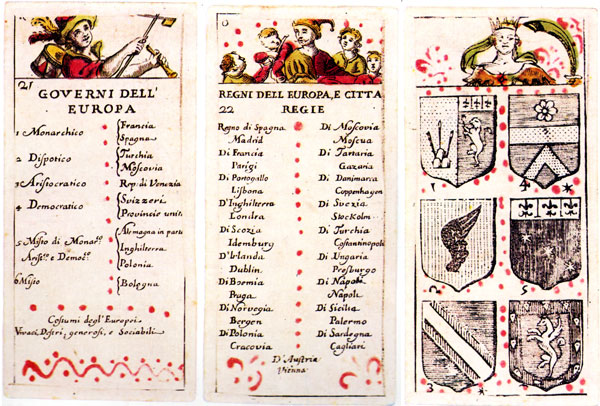
Above: Geographical and Heraldic Tarocchi cards from Bologna, 1725.
Early evidence that playing cards were being used in Italy comes from Florence in 1376, when a game called 'naibbe' is forbidden in a decree, with the implication that the game had only recently arrived there. This is followed in 1379 by another reference from Viterbo (in the vicinity of Rome) in which it is claimed that a new game called 'nayb' was introduced by a 'Saracen' (= Oriental, Arab or Muslim). We infer that the game was still a novelty, even it's name was still something of a mystery. However, quite soon playing cards did not meet with approval from the church authorities, and they were demonised by preachers who urged that they be destroyed.
The generally accepted view is that the Arabs introduced playing cards to Europe, via both the Iberian and Italian peninsulas, in the second half of the fourteenth century, and that European cards evolved from the suit system and composition of these cards. The famous Topkapi Museum pack, made from several incomplete Mamluk packs, clearly shows four suits of 13 cards including 3 court cards. Through a process of assimilation and adaptation the original Arabic suit symbols, and even the name na'ib, became Westernised. The typical Italian suit system uses the same symbolic objects as the Spanish (cups, coins, swords and clubs), with some differences of style dating back to an early stage in their history.
Italy did not form a single kingdom; several important ducal dynasties included the Visconti's, the Borgia's and the Scaliger's. There was the kingdom of Naples, the Vatican, the republics of Genova, Venice and Florence.
Italian-suited cards from the Venice area were probably the first ones to cross the Alps and Italian-suited trappola cards survived for some time in Austria, Poland, Czech Republic, Germany and the Balkans. Cards from Southern Italy, including Sicily, are closer in design to Spanish cards. It is here that the Spaniards had come to Italy bringing with them their beloved playing cards and gambling habits.
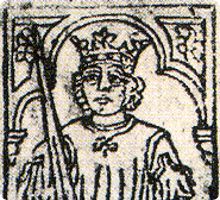
A specimen of XV century Italian cards shows that the suit symbols and court hierarchy were indeed very close to the Mamluk set, and have not changed much since then. One characteristic of early Italian cards is that the edges of the back paper, which had a pattern or design printed on it, were wrapped around the edges of the card thereby providing a border around the front. This artesanal method of production is more time-consuming but produces stiff and robust cards which handle and shuffle particularly well. Some early Spanish cards were also manufactured using this technique.
Italy has produced a number of variant types of extended packs. The hand-painted tarot cards, which date probably from the first half of the fifteenth century, contain 78 cards. In this game, apart from the four Italian/Latin suits, which could be said to derive from the Arabic 'Mamluk' suit symbols, there are also 22 trump cards; and there are 4 court cards per suit, including a king, queen, cavalier and page plus numeral cards 1-10, making a total of 78 cards. A variant called "Bologna Tarocchino" has only 62 cards (omitting numerals 2-5). Florentine Minchiate has a total of 97 cards.

Regional Patterns
Italy today enjoys reasonable political unity, but this has not always been the case. The fourteen regional patterns found in Italy reflect the history of French, Spanish and Imperial influences. The outcome today is that the north-west use French suit signs, the north and north-east use Italian suited packs and in the southern two-thirds of the peninsula Italo-Spanish suit signs prevail.
Bergamo Pattern Brescian Florentine Genoese Lombardy (Milanesi) Napolitan Piacentine Piedmont Primiera Bolognese Romagnole Sarde Sicilian Spanish National Pattern Tarocco Bolognese Trentine Trevisane (Venetian) Triestine Tuscan Pattern
Minchiate & Tarot
Tarocchi di Mantegna Visconti Tarocchi Minchiate Fiorentine "Etruria" Minchiate Minchiate c.1850 Tarocco Bolognese Mitelli Tarocchini Serravalle-Sesia Tarot Sola-Busca Tarot Tarocco Neoclassico Tarocco della “Corona Ferrea” Tarocchino Lombardo Tarocco Piemontese Tarocco Siciliano Tavaglione Stairs of Gold Tarot
Other Stuff
Agostino Bergallo Archaic North Italian Austrian Lloyd Steamship Co Pedro Bosio Carte da Indovino Carte Romane Carte per Signora Cucco Giuseppe Cattino Pavol Montanar Credito Commerciale Gumppenberg Lamperti (Milan), c.1820 Mamluk Cards Matarelli Transformation Mitelli ‘Gioco di Passatempo’ Modiano Cartine da Gioco Antonio Monasta "Moorish" Playing Cards Pinocchio Sardinia Spain Modiano ‘World Bridge’ Vienna pattern
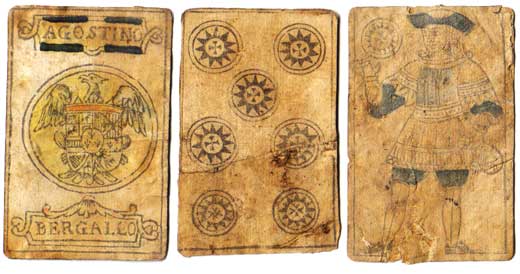
Above: woodblock-printed and stencil-coloured Spanish-suited playing cards made in Italy by Agostino Bergallo for export to Spanish territories, 18th century. The Ace of Coins carries the maker's name and the Spanish coat-of-arms.


By Simon Wintle
Member since February 01, 1996
Founder and editor of the World of Playing Cards since 1996. He is a former committee member of the IPCS and was graphics editor of The Playing-Card journal for many years. He has lived at various times in Chile, England and Wales and is currently living in Extremadura, Spain. Simon's first limited edition pack of playing cards was a replica of a seventeenth century traditional English pack, which he produced from woodblocks and stencils.
Related Articles

Le carte da gioco Arcimboldo
Courts and suit-signs inspired by the works of the Italian Renaissance painter, Giuseppe Arcimboldo....

22 Pittori in 22 Arcani
Collaborative Tarot with contributions from 22 different Italian artists including Menegazzi and Tav...

Justice playing cards
Ethical concepts in a deck produced by Riccardo Conturbia’s Passione Playing Cards Ltd.

Alan Tarot Deck
Reprint of a Tarock pack originally designed by Argio Orell for the Austrian Lloyd shipping company....

Il Tarocco del Mondo Nuovo
Imaginative Tarot card designs by Amerigo Folchi relating to Columbus and the New World.

22 Artisti Liguri in 22 Arcani
Collaborative set of major arcana devoted to Christopher Columbus and his voyages of discovery.

Carte di Colombo
Fully illustrated pack designed by Pier Canosa commemorating the 500th anniversary of the discovery ...

Carte di Natale
Designed by Pier Canosa as a Christmas pack for the Cortina Art Gallery in Milan.

Lyon pattern made in Italy by Pietro de Santi
The Lyon pattern was initially developed in France during the 16th century. As Lyon was a trading hu...

Laurenzo Propagine
Spanish-suited cards made in Italy by Laurenzo Propagine.

Il Tarocco Mitologico
Fully pictorial Tarot designed by Amerigo Folchi with figures mainly from Greek mythology.

Neapolitan pattern by Luigi Pignalosa, Naples
Two versions of the Neapolitan pattern from the British Museum by Luigi Pignalosa, Naples, 1875 & 18...

Rouen Pattern - Portrait Rouennais
An attractive XV century French-suited design from Rouen became the standard English & Anglo-America...

Dylan Dog
Characters and objects from the Italian comic book series Dylan Dog, written by Tiziano Sciavi and d...

Royal Britain
Pack devised by Pietro Alligo depicting English monarchs from Alfred the Great to Elizabeth II.

Ganjifa - Playing Cards from India
Indian playing cards, known as Ganjifa, feature intricate designs with twelve suits and are traditio...
Most Popular
Our top articles from the past 28 days


